How Pallet Inverters Solve GMP Compliance and Labor-saving Automation in Malaysia?
Handling goods in a strictly regulated environment like food, beverage, or pharmaceuticals presents a constant challenge. You need to move products efficiently, but you also have to meet Good Manufacturing Practice (GMP) standards. This often means switching from wooden pallets, which can harbor contaminants, to clean, plastic ones. At the same time, manual labor is expensive and a source of workplace injuries. Many Malaysian businesses I talk to are caught between these two pressures: maintaining compliance and controlling costs. They struggle with the slow, labor-intensive process of manually transferring goods from one pallet to another, which creates bottlenecks and risks product damage or contamination.
A pallet inverter is a machine that automates the process of switching pallets. It securely clamps a loaded pallet, rotates it 180 degrees, and allows for the easy exchange of the bottom pallet. This solves GMP compliance by enabling a quick and hygienic transfer from external, often wooden, pallets to internal, sanitized plastic or metal pallets. It also achieves labor-saving automation by replacing a manual, multi-person task with a swift, single-operator process. This directly reduces labor costs, minimizes the risk of worker injury, and speeds up the entire handling operation, making it a critical solution for modern Malaysian manufacturing.
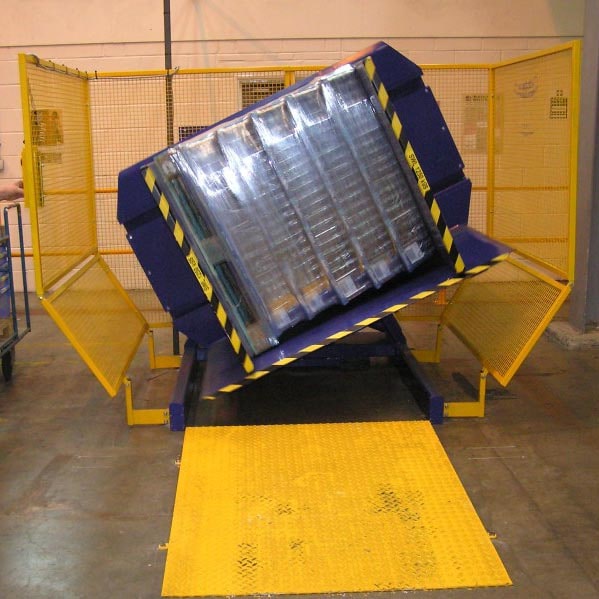
This solution seems straightforward, but implementing it correctly is key to unlocking its full potential. You need to understand how this equipment directly impacts your GMP protocols and how to quantify the real savings it brings. As someone who has designed, built, and implemented these systems for years, I want to walk you through the details. Let's explore how pallet inverters work, why they are so effective in the Malaysian context, and what you should look for to ensure you are making a smart investment for your business.
How exactly do pallet inverters enforce GMP standards in production lines?
In any industry governed by Good Manufacturing Practices, control over the production environment is everything. A major weak point is often the receiving dock. Goods arrive on external pallets, usually wood, which have been exposed to moisture, pests, and all sorts of contaminants. Bringing these pallets into your clean production area is a huge GMP violation. This forces companies into a difficult manual process of destacking, transferring goods by hand, and restacking onto clean, in-house pallets. This process is not only slow but also introduces risks of human error, product damage, and cross-contamination.
A pallet inverter enforces GMP standards by creating a clear, controlled barrier between "dirty" external areas and "clean" internal production zones. The machine allows you to swap the incoming wooden pallet for a sanitized plastic or aluminum pallet right at the entry point. The entire load is handled as a single, stable unit, preventing goods from being touched or exposed to the environment. This automated transfer eliminates the risks associated with manual handling and ensures that only clean, compliant pallets enter your sensitive production areas, creating a robust and auditable link in your GMP chain of custody.
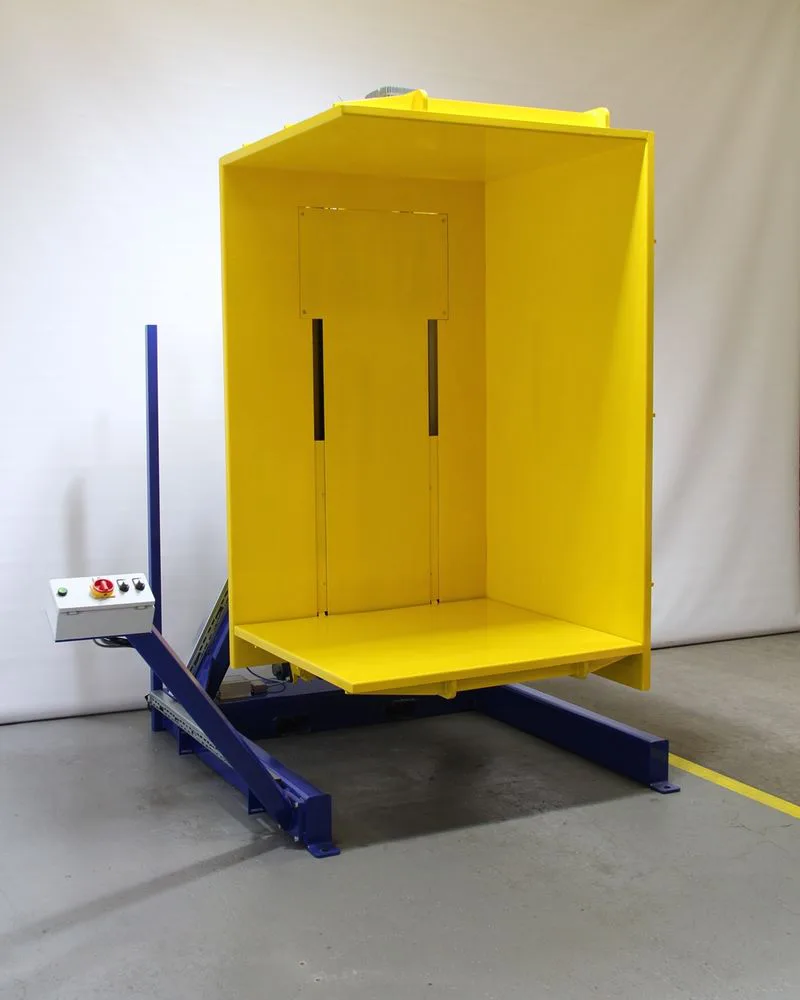
Let's dive deeper into the specific mechanisms that make this possible. It’s not just about swapping the pallet; it's about how the process itself strengthens your quality control system. From my experience helping clients integrate these machines, the benefits go far beyond a simple pallet exchange.
Creating a Physical "Hygiene Lock"
The pallet inverter acts as a physical gatekeeper. You can design your facility layout so that forklifts from the receiving bay can only place pallets into the inverter from one side. After the 180-degree rotation and pallet exchange, a different forklift from the clean zone retrieves the load from the other side. This creates a clear demarcation line. There is no chance for a contaminated pallet or the forklift that carried it to cross into the clean environment. This simplifies traffic management and makes GMP compliance visual and easy to enforce for all staff. It's a simple, mechanical solution to a complex logistical problem.
Maintaining Product Integrity
Manual handling is risky. Workers can drop boxes, damage packaging, or accidentally contaminate products. A pallet inverter clamps the entire load securely with adjustable pressure before it begins to rotate. This ensures that even delicate or irregularly stacked goods are held firmly in place throughout the transfer. The smooth, controlled motion minimizes shock and vibration. I've seen clients in the beverage industry use these to handle stacks of glass bottles without a single issue. By keeping the product stack intact, you not only prevent costly damage but also uphold the quality standards that GMP is designed to protect.
Enhancing Traceability and Documentation
Modern pallet inverters can be integrated with your Warehouse Management System (WMS) or Manufacturing Execution System (MES). When a load is processed, the system can automatically log the event. This creates a digital record confirming that the pallet was swapped according to protocol.
| GMP Compliance Factor | Manual Transfer Method | Automated Pallet Inverter Method |
|---|---|---|
| Contamination Risk | High (floor contact, manual touch) | Minimal (load is clamped, no touch) |
| Process Control | Inconsistent (depends on worker) | Consistent and repeatable |
| Documentation | Manual logs, prone to error | Automated, integrated with WMS/MES |
| Product Damage Risk | High (dropping, improper handling) | Low (secure clamping, smooth motion) |
| Time to Complete | 10-15 minutes per pallet | 1-2 minutes per pallet |
This automated documentation is invaluable during GMP audits. You can instantly pull up records to prove that every incoming pallet load went through the required hygiene procedure. This level of traceability is difficult and time-consuming to achieve with a manual system. It transforms a compliance task from a liability into a well-documented strength.
What are the real labor and cost savings from automating with a pallet inverter?
Many factory managers I meet in Malaysia are facing intense pressure from rising labor costs and a shortage of skilled workers. Manually transferring a full pallet of goods is a terrible use of this valuable human capital. It typically requires two or three workers to break down a stack, move the boxes, and then rebuild it on a new pallet. This is slow, physically demanding work that leads to fatigue, mistakes, and, worst of all, workplace injuries from repetitive lifting. The direct cost of these workers' time is obvious, but the indirect costs—recruitment, training, injury claims, and production delays—are often even larger.
Automating this task with a pallet inverter delivers immediate and measurable savings by transforming a multi-person, 15-minute job into a one-person, 2-minute operation. The primary saving comes from reallocating labor from this low-value, high-risk task to more productive areas of your facility. A single operator can now manage the work of an entire team, drastically cutting the man-hours required per pallet. This reduction in labor dependence not only lowers payroll costs but also improves operational efficiency and reduces the significant financial risk associated with workplace injuries.
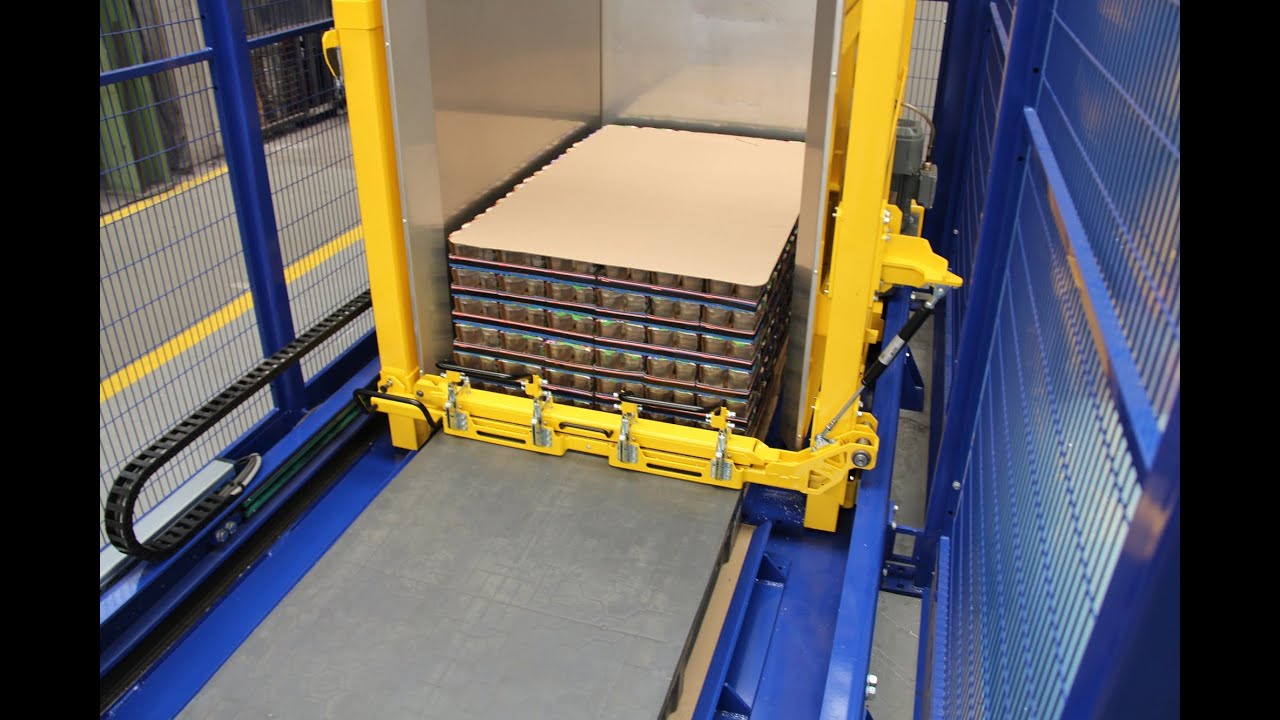
The savings on a spreadsheet are one thing, but to truly understand the impact, we need to look at the ripple effects across your entire operation. Based on my work with factories that have made this switch, the benefits accumulate in ways you might not expect. Let's break down the tangible and intangible returns.
Calculating the Direct ROI
The most straightforward calculation is based on labor. Let's assume you have a team of two workers handling pallet transfers. They might take 10 minutes per pallet. If a pallet inverter reduces this to one operator taking 2 minutes, you are saving 18 man-minutes for every single pallet you process.
Now, let's put some numbers to that.
- Manual Method: 2 workers x 10 minutes = 20 man-minutes per pallet
- Inverter Method: 1 operator x 2 minutes = 2 man-minutes per pallet
- Time Saved: 18 man-minutes per pallet
If you process 100 pallets a day, that's 1,800 man-minutes, or 30 man-hours, saved every single day. Multiply that by your average hourly labor cost, and you can quickly see how the machine pays for itself. In many Malaysian factories I've worked with, the payback period is often less than 18 months based on labor savings alone.
Reducing Indirect and Hidden Costs
The financial benefits don't stop at payroll. Think about the hidden costs of manual labor that simply disappear with automation.
| Cost Category | Manual Handling Impact | Pallet Inverter Impact |
|---|---|---|
| Workplace Injury Claims | High risk of back strains and repetitive motion injuries, leading to medical costs and lost time. | Virtually eliminated. The operator uses controls, not muscle. |
| Product Damage | Significant risk of dropped or crushed boxes during transfer, leading to write-offs. | Minimal. The load is secured and moved as a single unit. Savings here can be 1-2% of product value. |
| Employee Turnover & Training | Physically demanding jobs have high turnover. Constant need to recruit and train new staff. | Higher-skilled, less physically demanding role. Leads to better employee retention. |
| Operational Bottlenecks | Manual transfer is slow and unpredictable, creating a major bottleneck at receiving or shipping. | Fast, consistent cycle time (e.g., 90 seconds per pallet) makes workflow smooth and predictable. |
One of my clients in the food ingredients sector was constantly writing off thousands of dollars worth of damaged bags of powder each month. After installing a pallet inverter, their product damage rate from pallet transfers dropped to nearly zero. Those savings went straight to their bottom line, accelerating the machine's ROI far beyond the initial labor calculations.
Why are pallet inverters becoming essential for Malaysian manufacturing hubs?
Malaysia's manufacturing sector is a cornerstone of its economy, especially in key hubs like Penang, Selangor, and Johor. These regions are competing on a global stage. In the past, a large labor pool was a competitive advantage. Today, that's changing fast. I see it every time I visit. Companies are dealing with rising wages, a greater focus on worker safety standards, and intense pressure from international clients to demonstrate strict quality control, like GMP or ISO standards. Simply put, the old way of doing things with manual labor is no longer sustainable or competitive.
Pallet inverters are becoming essential for Malaysian manufacturers because they directly address these modern challenges. They provide a powerful solution for automation that simultaneously cuts labor costs, improves worker safety, and strengthens quality compliance. For an export-oriented economy like Malaysia's, being able to prove robust, automated, and compliant handling processes is no longer a "nice to have"—it's a requirement to win and retain business with major international partners in the food, pharmaceutical, and electronics industries. This single piece of equipment helps Malaysian companies level up their operational capabilities to meet global standards.
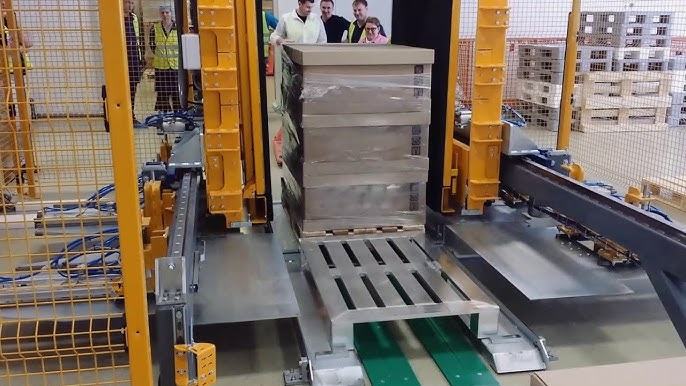
To appreciate why this trend is accelerating, we need to consider the specific economic and regulatory forces at play in Malaysia. It’s a story of a nation rapidly moving up the value chain, and the machinery on the factory floor needs to keep pace.
The Economic Shift: From Labor-Intensive to Tech-Driven
For years, Malaysia's growth was fueled by its manufacturing strength, which often relied on a large and affordable workforce. However, the economic landscape has matured. The government's push towards Industry 4.0, coupled with a natural rise in living standards, means that labor is no longer cheap. Businesses must now compete on efficiency, quality, and technology.
I was recently talking to a factory owner in Shah Alam. He told me his biggest headache wasn't finding customers; it was finding reliable workers for his warehouse. Young people don't want physically demanding jobs. By investing in automation like pallet inverters, he was able to:
- Reduce his reliance on manual labor: This solved his recruitment problem.
- Upskill his existing workforce: The workers who previously did manual lifting were trained to be machine operators, a more desirable and higher-value role.
- Increase throughput: He could process more goods with the same number of people, boosting overall productivity.
This story is becoming more and more common across Malaysia. Automation is no longer a luxury; it's a core strategy for survival and growth.
Meeting Global Export Standards
Malaysian companies that export to Europe, North America, or Japan face incredibly high standards. Their customers—and their customers' governments—demand proof of quality control at every step.
| Standard Requirement | How a Pallet Inverter Helps |
|---|---|
| GMP (Good Mfg. Practice) | Enables hygienic pallet swapping, a core requirement for food & pharma. |
| HACCP (Hazard Analysis) | Eliminates a key contamination hazard (dirty pallets) from the process flow. |
| ISO 9001 (Quality Mgmt) | Creates a standardized, repeatable, and documented process for product handling. |
| Customer Audits | Provides a clear, visible demonstration of modern, compliant, and safe handling procedures. |
A pallet inverter is a very visible and effective way to demonstrate this commitment. When an auditor from a major multinational visits a Malaysian factory, seeing an automated, clean pallet exchange process at the receiving dock sends a powerful message. It says, "We are serious about quality. We invest in the right technology to protect our product and your brand." This builds trust and is often a key factor in securing large, long-term contracts. It's a machine that helps sell your product before it's even made.
My Insights on Choosing a Partner, Not Just a Machine
When you’re considering a significant equipment purchase like a pallet inverter, it’s easy to get lost in specifications, features, and prices. But after more than two decades in this industry, from working on the factory floor to building my own company, I can tell you this: you are not just buying a piece of steel. You are investing in a solution to a problem, and for that, you need a partner, not just a supplier. A machine is only as good as the understanding and support behind it.
My advice is to look beyond the machine itself and evaluate the team you'll be working with. A true partner takes the time to understand your unique challenges—your product, your facility layout, your workflow, and your business goals. They don't just sell you a standard model; they help you configure the right solution. This partnership approach ensures the equipment will integrate seamlessly into your operation and deliver the maximum possible return on your investment for years to come.
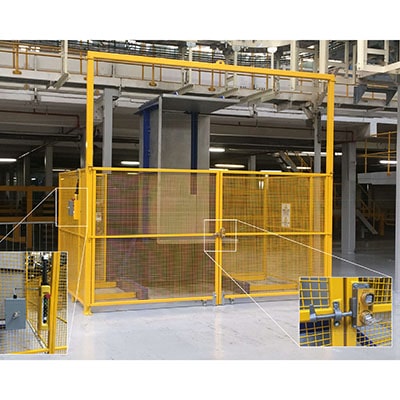
I built SHJLPACK on this very principle. I started as an engineer, and I remember the frustration of seeing clients receive equipment that wasn't quite right for their needs. When I founded my own factory, I made a promise to do things differently. It's about collaboration. Let me share what that means in practice.
Look for Deep Application Knowledge
A good supplier knows their machine. A great partner knows your industry. When you speak with a potential vendor, ask them about their experience with products like yours.
- Have they handled bags of powder, glass bottles, or sterile pharmaceutical vials before?
- Do they understand the specific clamping pressure needed for your product to avoid damage?
- Can they advise on stainless steel construction for food-grade washdown environments versus standard steel for general logistics?
This expertise is critical. I remember a client in the dairy industry who needed to swap pallets in a cold, wet environment. A standard machine would have corroded and failed within a year. We worked with them to design a fully stainless steel, washdown-rated pallet inverter with sealed electronics. The initial cost was higher, but the machine is still running perfectly a decade later. A supplier just trying to make a sale would have sold them the standard, cheaper model, which would have ended up costing them far more in the long run.
The Importance of a Long-Term View
Your relationship with a vendor shouldn't end when the payment is made. A strategic partner is there for the entire lifecycle of the equipment. Before you buy, ask about their support structure.
| Partnership Aspect | What to Ask Your Vendor | Why It Matters for Your ROI |
|---|---|---|
| Installation & Commissioning | "Will your technicians be on-site to install the machine and train my operators?" | Proper setup is key to performance. Good training reduces operator error and boosts adoption. |
| After-Sales Support | "What is your process for providing spare parts and technical support?" | When a machine is down, production stops. Fast access to parts and expertise is crucial. |
| Future-Proofing | "Can this machine be upgraded or integrated with other systems (like conveyors or AGVs) later?" | Your needs will change. A good partner helps you buy a machine that can grow with your business. |
I've achieved my own success because my clients succeeded. Their growth fueled mine. That's why I am so passionate about sharing what I've learned. My goal with SHJLPACK isn't just to sell machines; it's to provide the knowledge that helps you make the right choice. A pallet inverter is a tool. The right partner helps you turn that tool into a genuine competitive advantage.
Conclusion
Pallet inverters provide a direct solution for GMP compliance and labor-saving automation, boosting efficiency and safety while cutting costs, making them essential for modern manufacturing in Malaysia and beyond.



